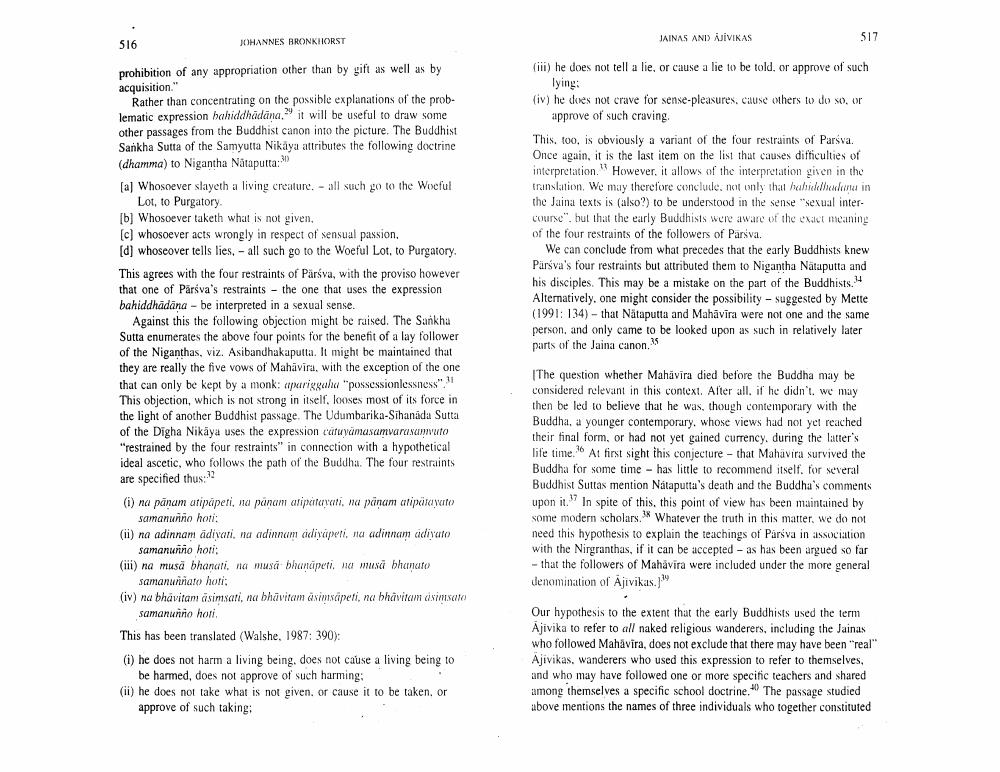Book Title: Riddle Of Jainas And Ajivikas In Early Buddhist Literature Author(s): Johannes Bronkhorst Publisher: Johannes Bronkhorst View full book textPage 4
________________ JAINAS ANI) AJIVIKAS 517 516 JOHANNES BRONKHORST prohibition of any appropriation other than by gift as well as by acquisition." Rather than concentrating on the possible explanations of the problematic expression hahiddhädäna, it will be useful to draw some other passages from the Buddhist canon into the picture. The Buddhist Sankha Sutta of the Samyutta Nikaya attributes the following doctrine (dhamma) to Nigantha Nätaputta: [a] Whosoever slayeth a living creature. - all such go to the Wocful Lot, to Purgatory [b] Whosoever taketh what is not given, (c) whosoever acts wrongly in respect of sensual passion, (d) whoseover tells lies. - all such go to the Woeful Lot, to Purgatory, This agrees with the four restraints of Paráva, with the proviso however that one of Pārsva's restraints - the one that uses the expression bahiddhādāna - be interpreted in a sexual sense. Against this the following objection might be ruised. The Sankha Sutta enumerates the above four points for the benefit of a lay follower of the Niganthas, viz. Asibandhakaputta. It might be maintained that they are really the five vows of Mahavira, with the exception of the one that can only be kept by a monk: apariggahu "possessionlessness". This objection, which is not strong in itself. looses most of its force in the light of another Buddhist passage. The Udumbarika-Sihanada Sutta of the Digha Nikāya uses the expression caruyamasamvaranumito "restrained by the four restraints" in connection with a hypothetical ideal ascetic, who follows the path of the Buddha. The four restraints are specified thus:12 (i) na panum atipaperi, na panam alipotovati, na ponam aliparayuto samanunno hoti: (ii) na adinnam adivari, na adinnam adivapoi, nu adinnam divato samanunño hoti: (iii) na musā bhanali na nusa bhuncpeti, na musa bhanato samanunnaro hori: (iv) na bhavitam asimsati, na bhūvitam asinsapeti, na bhavitam dsinisalo samanunno hori (iii) he does not tell a lie, or cause a lie to be told, or approve of such lying: (iv) he does not crave for sense pleasures. cause others to do so. or approve of such craving. This. too, is obviously a variant of the four restraints of Parsva. Once again, it is the last item on the list that causes difficulties of interpretation. However, it allows of the interpretation given in the translation. We may therefore conclude, not only that habillbona in the Jaina texts is also?) to be understood in the sense "sexual interCourse". but that the early Buddhists were aware of the exact meaning of the four restraints of the followers of Parsva. We can conclude from what precedes that the early Buddhists knew Parsva's four restraints but attributed them to Nigantha Nataputta and his disciples. This may be a mistake on the part of the Buddhists.14 Alternatively, one might consider the possibility - suggested by Mette (1991: 134) - that Nätaputta and Mahavira were not one and the same person, and only came to be looked upon as such in relatively later parts of the Jaina canon. The question whether Mahavīra died before the Buddha may be considered relevant in this context. Alter all, if he didn't. We may then be led to believe that he was, though contemporary with the Buddha, a younger contemporary, whose views had not yet reached their final form, or had not yet gained currency. during the latter's life time. At first sight this conjecture - that Mahavira survived the Buddha for some time has little to recommend itself. for several Buddhist Suttas mention Nataputta's death and the Buddha's comments upon it. In spite of this, this point of view has been maintained by some modern scholars. Whatever the truth in this matter, we do not need this hypothesis to explain the teachings of Parsva in association with the Nirgranthas, if it can be accepted -as has been argued so far - that the followers of Mahavira were included under the more general denomination of Ajivikas.) This has been translated (Walshe, 1987: 390): (i) he does not harm a living being, does not cause a living being to be harmed, does not approve of such harming: (ii) he does not take what is not given. or cause it to be taken. or approve of such taking: Our hypothesis to the extent that the early Buddhists used the term Ajivika to refer to all naked religious wanderers, including the Jainas who followed Mahavira, does not exclude that there may have been "real" Ajivikas, wanderers who used this expression to refer to themselves, and who may have followed one or more specinc teachers and shared among themselves a specific school doctrine. The passage studied above mentions the names of three individuals who together constitutedPage Navigation
1 2 3 4 5 6 7 8 9 10
